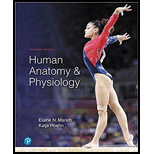
Concept explainers
Match each of the following key terms (a–i) with its description below: Key:
a. alleles
b. autosomes
c. dominant allele
d. genotype
e. heterozygote
f. homozygote
g.
h. recessive allele
i. sex chromosomes
____ (1) genetic makeup
____ (2) how genetic makeup is expressed
____ (3) chromosomes that dictate most body characteristics
____ (4) alternate forms of the same gene
____ (5) an individual bearing two alleles that are the same for a particular trait
____ (6) an allele that is expressed whether in single or double dose
____ (7) an individual bearing two alleles that differ for a particular trait
____ (8) an allele that must be present in double dose to be expressed
To review:
The key terms in column A with their description in column B.
| Column A | Column B |
| Alleles | Genetic makeup |
| Autosomes | How genetic makeup is expressed |
| Dominant allele | Chromosomes that dictate most body characteristics |
| Genotype | Alternate forms of the same gene |
| Heterozygote | An individual bearing two alleles that are the same for a particular trait |
| Homozygote | An allele that is expressed whether in single or double dose |
| Phenotype | An individual bearing two alleles that differ for a particular trait |
| Recessive allele | An allele that must be present in double dose to be expressed |
| Sex chromosome |
Introduction:
Heredity refers to the transfer of characteristics or traits from one generation to another generation by different means of reproduction. Genetics is the branch of biology, in which heredity is studied.
Explanation of Solution
Alleles: Genes are the DNA (deoxyribonucleic acid) segments that code for proteins. The alleles are the alternate form of a gene that is located on the homologous chromosome at the same locus. So, (a) can be correctly matched with (4).
Autosomes: Autosomes and allosomesor sex chromosomes are the two types of chromosomes. The autosomes are the chromosomes that do not determine the sex of an organism. These are involved in the determination of the body characteristics. So, (b) can be correctly matched with (4).
Dominant allele: The allele that suppresses or masks the expression of another allele is known as a dominant allele. It is represented by a capital letter. These alleles are expressed when present in either single dose or in a double dose. So, (c) can be correctly matched with (6).
Genotype: The genetic makeup of a person is known as a genotype. It determines the properties or characteristics called phenotype of an individual. So, (d) can be correctly matched with (1).
Heterozygote: Heterozygote refers to an individual that have two alternative forms or alleles of a gene or genes, which are different for a particular trait. Thus, it produces varying offspring. So, (e) can be correctly matched with (7).
Homozygote: Homozygote refers to an individual, who possess two identical alleles for a specific gene coding for a particular trait, one of which is inherited from each of the parents. So, (f) can be correctly matched with (7).
Phenotype: The physical characteristics of a trait is known as phenotype. It is defined by the genetic makeup or genotype of an organism. So, (g) can be correctly matched with (2).
Recessive allele: The allele, whose expression is masked by the dominant allele is known as a recessive allele. They can be expressed when present in double dose are represented by the lowercase alphabets. So, (h) can be correctly matched with (8).
| Column A | Column B |
| Alleles | (4) Alternate forms of the same gene |
| Autosomes | (3) Chromosomes that dictate most body characteristics |
| Dominant allele | (6) An allele that is expressed whether in single or double dose |
| Genotype | (1) Genetic makeup |
| Heterozygote | (7) An individual bearing two alleles that differ for a particular trait |
| Homozygote | (5) An individual bearing two alleles that are the same for a particular trait |
| Phenotype | (2) How genetic makeup is expressed |
| Recessive allele | (8) An allele that must be present in double dose to be expressed |
| Sex chromosome |
Want to see more full solutions like this?
Chapter 29 Solutions
HUMAN ANATOMY+PHYSIOLOGY-PKG.
- Noggin mutation: The mouse, one of the phenotypic consequences of Noggin mutationis mispatterning of the spinal cord, in the posterior region of the mouse embryo, suchthat in the hindlimb region the more ventral fates are lost, and the dorsal Pax3 domain isexpanded. (this experiment is not in the lectures).a. Hypothesis for why: What would be your hypothesis for why the ventral fatesare lost and dorsal fates expanded? Include in your answer the words notochord,BMP, SHH and either (or both of) surface ectoderm or lateral plate mesodermarrow_forwardNot part of a graded assignment, from a past midtermarrow_forwardNot part of a graded assignment, from a past midtermarrow_forward
- please helparrow_forwardWhat does the heavy dark line along collecting duct tell us about water reabsorption in this individual at this time? What does the heavy dark line along collecting duct tell us about ADH secretion in this individual at this time?arrow_forwardBiology grade 10 study guidearrow_forward
 Biology (MindTap Course List)BiologyISBN:9781337392938Author:Eldra Solomon, Charles Martin, Diana W. Martin, Linda R. BergPublisher:Cengage Learning
Biology (MindTap Course List)BiologyISBN:9781337392938Author:Eldra Solomon, Charles Martin, Diana W. Martin, Linda R. BergPublisher:Cengage Learning Human Heredity: Principles and Issues (MindTap Co...BiologyISBN:9781305251052Author:Michael CummingsPublisher:Cengage Learning
Human Heredity: Principles and Issues (MindTap Co...BiologyISBN:9781305251052Author:Michael CummingsPublisher:Cengage Learning
 Human Biology (MindTap Course List)BiologyISBN:9781305112100Author:Cecie Starr, Beverly McMillanPublisher:Cengage Learning
Human Biology (MindTap Course List)BiologyISBN:9781305112100Author:Cecie Starr, Beverly McMillanPublisher:Cengage Learning Biology: The Unity and Diversity of Life (MindTap...BiologyISBN:9781305073951Author:Cecie Starr, Ralph Taggart, Christine Evers, Lisa StarrPublisher:Cengage Learning
Biology: The Unity and Diversity of Life (MindTap...BiologyISBN:9781305073951Author:Cecie Starr, Ralph Taggart, Christine Evers, Lisa StarrPublisher:Cengage Learning





